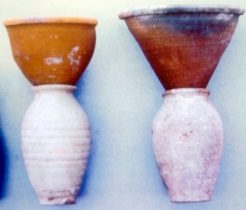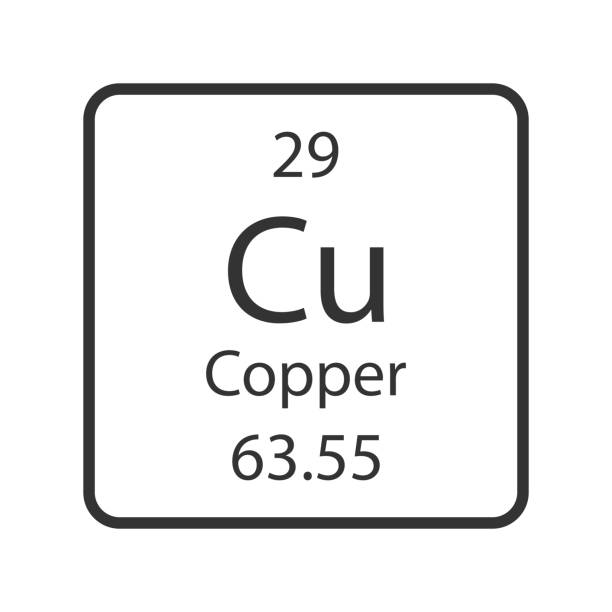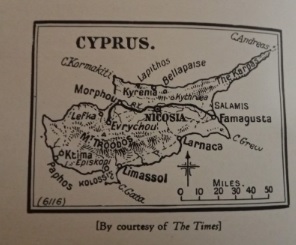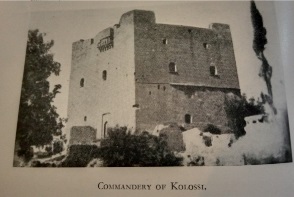We begin by going back in time nearly 750 years to 1291 and Cyprus in springtime. A boat approaches carrying just a handful of men – they are the only surviving Knights of the Order of St John who have fought at the Siege of Acre – the battle which ended with the loss of the Crusader Kingdom of Jerusalem and marked a fatal blow to Christian crusader ambitions in the Holyland.
On board was Jean de Villiers, the Grand Master of the Order of St John, who was seriously wounded and only survived because he had been rescued just in time and carried to the boat. Defeated, depleted, and demoralized, they escaped to Cyprus and retreated to Kolossi near Limassol where they already owned land; Kolossi had been granted to the Order in 1210 by King Hugh I and was now not only their place of refuge but would soon become their new headquarters.
While recovering from what was a spear wound, Jean de Villiers wrote this letter to the Prior of St Gilles, Guillaume de Villaret, a future grand master of the Order:
‘And thus, I and some of our brothers escaped, as it pleased God, most of whom were wounded and battered without hope of cure, and we were taken to the island of Cyprus. On the day that this letter was written we were still there, in great sadness of heart, prisoners of overwhelming sorrow.’
The Hospitallers were at their lowest – they had lost many experienced brothers and knights, possessions, incomes, and their crusading mission in the Holy Land. But the Order had been founded for charitable reasons and this ideal proved to be a guiding light through these dark times. They built a hospital in Limassol and were able to continue their work in caring for the poor and the sick.
To find out one of the ways they were able to be successful in continuing their hospitaller mission, let us travel forward in time to the 1960s. Bypassing Beatlemania and the Space Race, let’s head to the cinema. In 1964 the biggest film in cinemas and the highest grossing was Mary Poppins. Still popular today, one of the most memorable songs was ‘A spoonful of sugar’ and if we look at the lyrics, they tell us something that the Hospitallers had learned during their time in the Middle East: “A Spoonful of sugar helps the medicine go down”– this is indeed true! Sugar added to medicine helps to sweeten what can be a very bitter taste and medieval medicinal herbs could certainly taste very bitter. Also, adding sugar solution or syrup can transform the texture of any lumpy medicinal concoction – medieval herbs were often crushed or ground and made into a thick, grainy paste which was difficult to swallow. So, the addition of sugar to medicine was greatly beneficial – Mary Poppins knew this, and the Knights of St John knew this too. They were able to capitalise on this knowledge because sugar cane was grown in several places in Cyprus, and on the Kolossi Estate there was a sugar mill and refinery. The Hospitallers produced and exported sugar which increased their income and helped pay for more hospitals, and they added sugar, which also acted as a preservative, to medicine that was given to the sick.

In order to produce sugar, the canes had to be harvested, cut, and crushed to extract the juice which was then boiled and purified repeatedly to leave a mix of crystals and syrup. This syrupy mass was then poured into a conical pot that had a hole in the bottom and the pot was placed in a collecting jar which the liquid molasses would drain into, leaving a cone of solid sugar in the top pot, called a sugar loaf. There are hundreds of mountains and hills world-wide named sugar loaf after their resemblance to the traditional shape of a medieval sugar loaf and the most famous one is probably Sugar Loaf Mountain in Rio.
 Cyprus was a very suitable place to produce sugar, partly because there was so much copper there and copper was needed for the boiling pans. This was the best material to use because it could be hammered and shaped easily, it distributed heat more evenly than other metals and Copper naturally reacts to sugar, helping to prevent it from re-crystallising. In fact, the chemical symbol for copper, Cu, comes from the Latin Cuprum which means ’from Cyprus’.
Cyprus was a very suitable place to produce sugar, partly because there was so much copper there and copper was needed for the boiling pans. This was the best material to use because it could be hammered and shaped easily, it distributed heat more evenly than other metals and Copper naturally reacts to sugar, helping to prevent it from re-crystallising. In fact, the chemical symbol for copper, Cu, comes from the Latin Cuprum which means ’from Cyprus’.
To grow sugar cane a lot of water is needed and although Cyprus does not have a lot of rainfall, especially in the summer months, the factory at Kolossi was near the River Kouris and water irrigation systems were used to transport water from there. Sugar was one of the most valuable exports produced on Cyprus until the sixteenth century when sugar was being produced in huge amounts from sugar plantations which had been established in the Canary Islands and later Brazil, then after in the Caribbean and USA. Sugar from the New World was much cheaper than Cypriot sugar because large numbers of slave labour was involved in the production there. Working hours were long and conditions were unsafe – the death rate for enslaved workers on the plantations was high because of overwork, poor nutrition, and work conditions. So, the history of sugar trade is extremely unpleasant, and the experiences of workers were barbaric. (For further exploration into sugar and slavery, the Museum of London Docklands has a permanent exhibition with extensive information.)
In Cyprus, the Kolossi estate also included vineyards which produced several different wines, the most famous of which is Commandaria, a sweet dessert wine which was named after the commanderies where it was produced. This is the oldest wine in the world that is still being made today and the Commandaria St John variation is named after the Knights of St John.
 Before it was given the name Commandaria, it was served at the wedding of Richard I in Limassol in 1191 when upon tasting it he declared it to be ’the wine of kings and the king of wines.’ He conquered Cyprus on his way to the Holy Land to fight in the Crusades. Although this had not been his initial intention, he had sailed to Cyprus because some of his fleet of ships had been blown off course in a storm and were stranded or shipwrecked off the coast of Limassol. His sister Joanna and his bride-to-be Berengaria were on one of the ships that was stranded and anchored off Limassol and the survivors that reached dry land had been imprisoned by the self-appointed ruler of Cyprus, Isaac Comnenus. What happened next was described by Richard himself in a letter:
Before it was given the name Commandaria, it was served at the wedding of Richard I in Limassol in 1191 when upon tasting it he declared it to be ’the wine of kings and the king of wines.’ He conquered Cyprus on his way to the Holy Land to fight in the Crusades. Although this had not been his initial intention, he had sailed to Cyprus because some of his fleet of ships had been blown off course in a storm and were stranded or shipwrecked off the coast of Limassol. His sister Joanna and his bride-to-be Berengaria were on one of the ships that was stranded and anchored off Limassol and the survivors that reached dry land had been imprisoned by the self-appointed ruler of Cyprus, Isaac Comnenus. What happened next was described by Richard himself in a letter:
“As we were continuing our pilgrimage journey, we were diverted to Cyprus where we hoped to find the refuge of those of our number who had been shipwrecked. But the tyrant (Isaac Comnenus)…brought a strongly armed force…He robbed and despoiled as many as possible of our men…and imprisoned those dying of hunger…We did battle with our enemy and, thanks to divine assistance, obtained a speedy victory…We have subjected to ourselves the whole island of Cyprus…”
Ruling Cyprus had not been in his plan and Richard sold the island to the Knights Templar – thus beginning the association with the island and crusading orders. The Templars passed the island on to Guy of Lusignan who was king of Jerusalem and an ally of Richard, and the Lusignan dynasty ruled Cyprus for nearly 300 years.
So, after the fall of Acre in 1291, the Order of St John was thus able to recover and strengthen itself. A fleet was established and the Hospitallers became one of the principal naval powers in the Mediterranean. Wanting independence outside of Cyprus, it was time to move on and by the year 1310 the Order of St John had established a new home and headquarters on the island of Rhodes.




